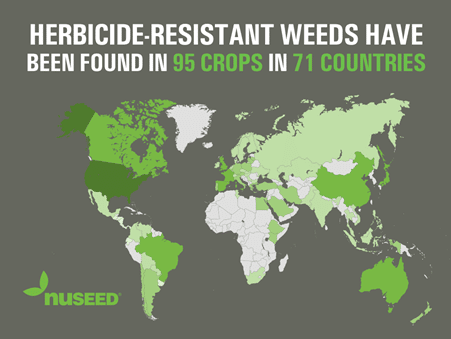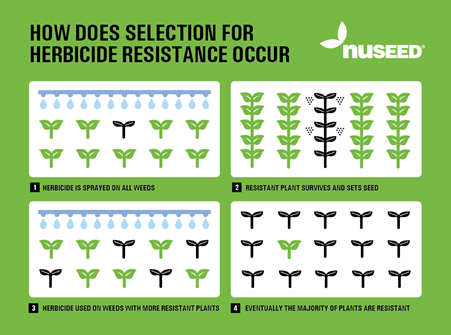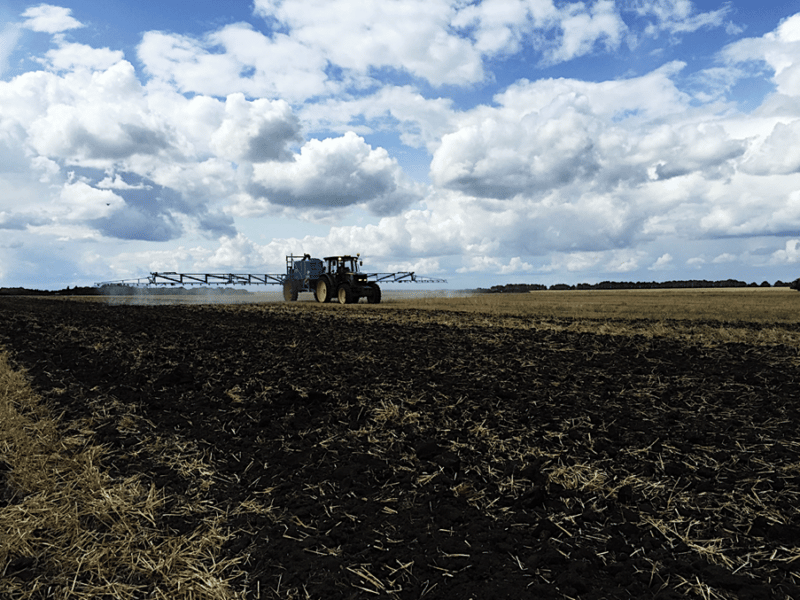Weed control is vital for high yields of good-quality arable crops, and the primary tool to control weeds are herbicides. However, there is a problem. Weeds have developed resistance to herbicides and, in some cases, are no longer being controlled, and the problem is getting worse. The International Herbicide-Resistant Weed Database reports that herbicide-resistant weeds have been found in 95 crops in 71 countries.

This article looks at the different types of herbicide resistance, the causes and how to mitigate against it.
History of herbicides
Ever since Neolithic farmers started to cultivate grains, they had to deal with weeds, initially by hand weeding but later by using new technology such as ploughing and hoeing. This worked well for thousands of years, mainly because there was an abundance of labour to do the work and yields, albeit low by modern standards, kept up with demand. Then two things happened that started the process towards developing and using herbicides.
First, the industrial revolution in Britain, Europe, and the United States (1760-1840) resulted in the mass migration of people from rural communities into urban areas, reducing the rural workforce available to undertake labour intensive jobs like weeding crops.
Second, the post WWII agricultural policies of many countries were focused on food security and increasing yields, and scientists started to look at the application chemical weapon’s technology developed during the war.
By 1946 the first modern herbicide, 2,4-D, was released for commercial use, and within 20 years, over 100 new chemicals were synthesized, developed, and in use. The uptake and use of herbicides were rapid because they were cheap, effective, and easy to use. By the 1970s, they were in mainstream use and contributed to significant improvements in crop yields.
| Although chemical herbicides didn’t take off until the 1950s, they have been around for a long time. Sinox, the first major organic chemical herbicide, was developed in France in 1896. |
History of herbicide resistance
The first recorded cases of herbicide resistance happened in the USA in the 1950s when Field bindweed (C. arvensis) was reported resistant to 2,4-D, and in the 1960s when Common groundswell (S. vulgaris) was reported resistant to simazine.
By the 1980s, the number of reported herbicide-resistant weeds began increasing rapidly. Today, there are currently 509 unique cases of herbicide-resistant weeds globally, with 266 species.
How herbicide resistance happens
In any population of weeds, you will find a very small number of individual plants that can tolerate a particular herbicide. They have a natural, built-in, inherent resistance to the herbicide. You rarely see these plants because they are controlled elsewhere in the rotation, and their population remains low and insignificant. However, if you continually use the same herbicide (or herbicide group) year after year, you will allow them to set seed and multiply. Essentially, by removing the “susceptible” weeds, you are actively selecting the “resistant” weeds. Left unchecked and the resistant weed population will continue to increase and reach levels that affect crop yields.

Herbicide resistance mechanisms
The mechanisms that give herbicide resistance are diverse but can be broadly divided into two types: target-site resistance and non-target-site resistance.
Target site resistance is an alteration in the plant at the normal herbicide site of action – the target site – and the herbicide no longer binds to its site of action, allowing the plant to survive herbicide treatments.
Non-target site resistance is mechanisms other than changes at the target site which enable a plant to survive herbicide application, such as reduced herbicide uptake, reduced translocation, reduced herbicide activation, and enhanced herbicide detoxification.
Plants can have more than one resistance mechanism, known as multiple resistance, which allows the plant to withstand herbicides from different groups.
| The difference between herbicide resistance, herbicide tolerance, and herbicide failure.
· Herbicide resistance is the inherited ability of an individual plant to survive a herbicide application that would kill a normal population. · Herbicide tolerance is the inherent ability to survive and reproduce after herbicide treatment at a standard use rate. · Herbicide failure is the failure of a herbicide because it was misapplied, such as the wrong rate, the wrong growth stage, the wrong target, too much drift, etc. |
Herbicide resistance strategy
The main objective is to avoid herbicide resistance happening in the first place. Once resistance has developed, it does not go away, and there are no new herbicide modes of action available.
The strategy is all about reducing the risk of herbicide resistance developing and requires a coordinated approach. Use mixtures or sequences of herbicides with different modes of action. Herbicides work by targeting specific plant processes, known as the “mode of action” (MOA), and herbicides are classified based on their MOA.
Common herbicide groups used in arable crop production:
| Group 1
|
ACCase inhibitors | Fops and Dims.
Typically, graminicides that work on actively growing grasses. Applied post-emergent. |
fluazifop-p-butyl
sethoxydim clethodim diclofop-methyl. |
| Group 2
|
ALS inhibitors | Block the enzyme used in proteins synthesis.
Typically applied post-emergent, contact action. |
Imazethapyr
tribenuron-methyl nicosulfuron. |
| Group 3 | Microtubule assembly inhibitors
|
Dinitroanilines.
Inhibit root cell division. They are applied to the soil before weed germination. Typically need to be incorporated |
trifluralin
ethalfuralin |
| Group 4 | Synthetic auxins | Disrupt plant cell growth in newly forming stems and leaves.
Applied to actively growing plants and have very little soil activity.
|
2,4-D
dicamba clopyralid aminopyralid MCPA MCPB |
Cultural control options are vital to reduce risks of herbicide resistance developing.
Crop rotation
Are you over-reliant on one or two crops and, as a result, repeatedly applying herbicides from the same group?
Different crops with different lifecycles help break the lifecycle of weeds and reduce the return of seeds to the weed bank. Crops from different plant families allow different herbicide modes of action to be used, making weed control more manageable and effective.
Establishment system
Repeated shallow cultivations and early drilling can encourage grassweeds; using cover crops, later drilling, and higher seed rates can be used to some effect.
Fallow
Non-cropping can be a very effective way of reducing weed populations, provided fresh seed return is prevented. Spot resistance early; it is cheaper and easier to stop resistance from developing, so spotting the early signs is vital.

View from the farm
We went on social media to ask farmers worldwide what the implications of herbicide resistance meant to their business and how they mitigated against it? Here are some replies.
Pierre, France
“Here, the main issue is blackgrass (A. myosuroides) resistance to group one and two herbicides…the main cause is a short rotation, unbalance between magnesium and potassium, a lack of calcium, and too much tillage.”
Teia, Spain
“Serious problem on farms in my area of NE Spain, especially for some grasses (lolium rigidum, bromus) or dicots (Papaver rhoeas) in winter cereals. Managed by crop rotation, using herbicides with different mechanisms of control, “false sowings”, mechanical weeding.”
Agrogenomica, Argentina
“Direct seeding has created herbicide resistance; when we return to conventional cultivations, the problems are mitigated.”
Bill, Africa
“Always use a three-way [herbicide] mix, even if one is a bit weak, if weed numbers are low then the need for the mix is reduced, rotate crop types where needed.”
Michael, USA
“Continuing no-tillage with lots of groundcover and cover crops whenever a cash crop isn’t planted, animal integration on farmland helps as they eat weed species before they set seed.”
Graeme, Australia
“There are many, but for low yielding environments, the loss of low-cost weed control measures is a significant issue; in higher-yielding environments, the returns facilitate more options.”
John, Australia
“Planning to buy a Seed Terminator in the near future” (Seed Terminator – an attachment to the combine that destroys weed seeds before they are returned to the field)
